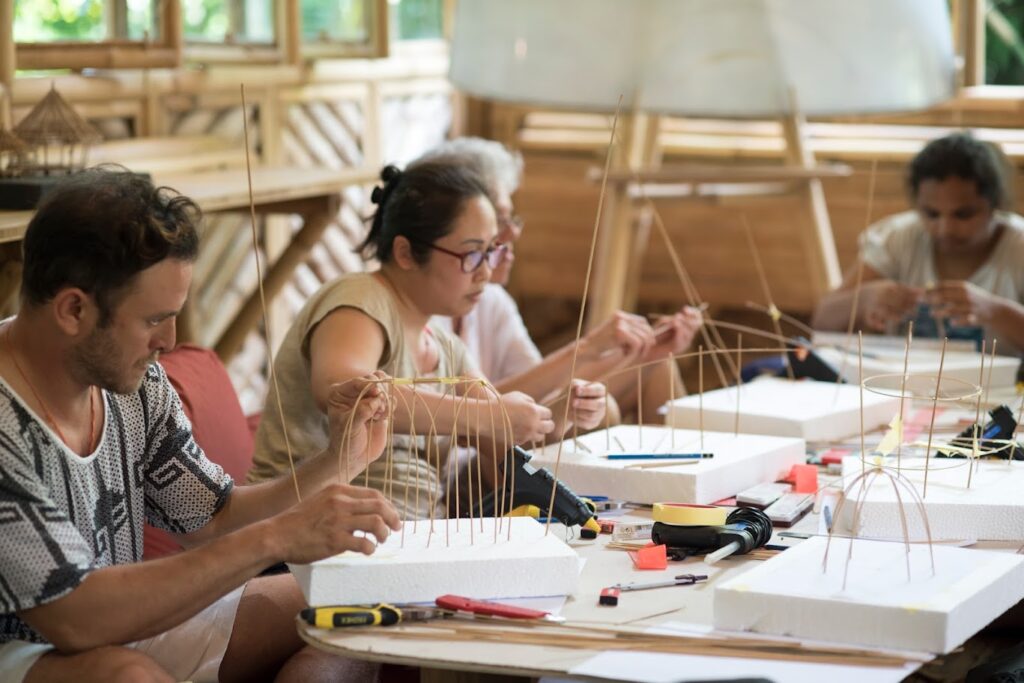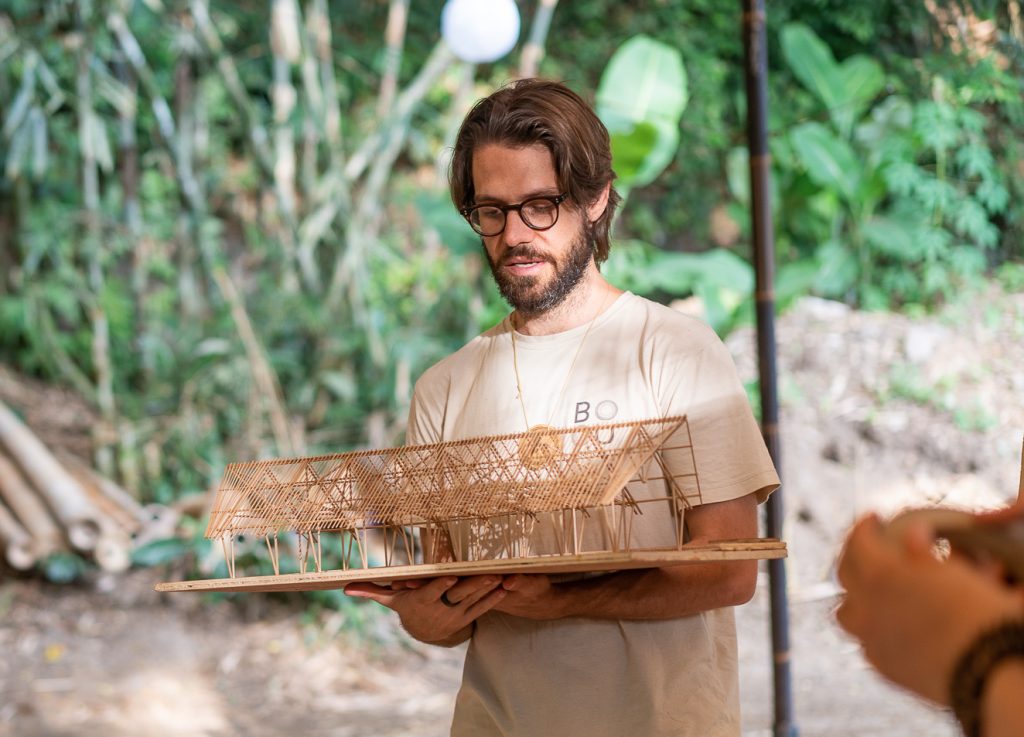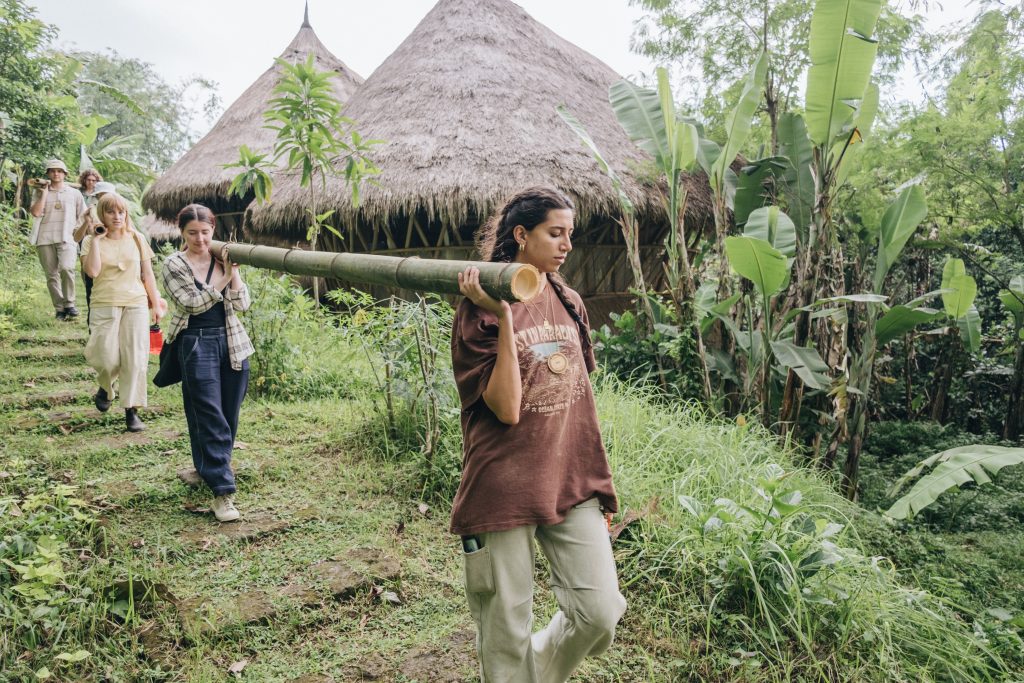Treating Bamboo in Your Backyard
By Shweta Lalwani | September 1, 2020 | Resources - Processing -
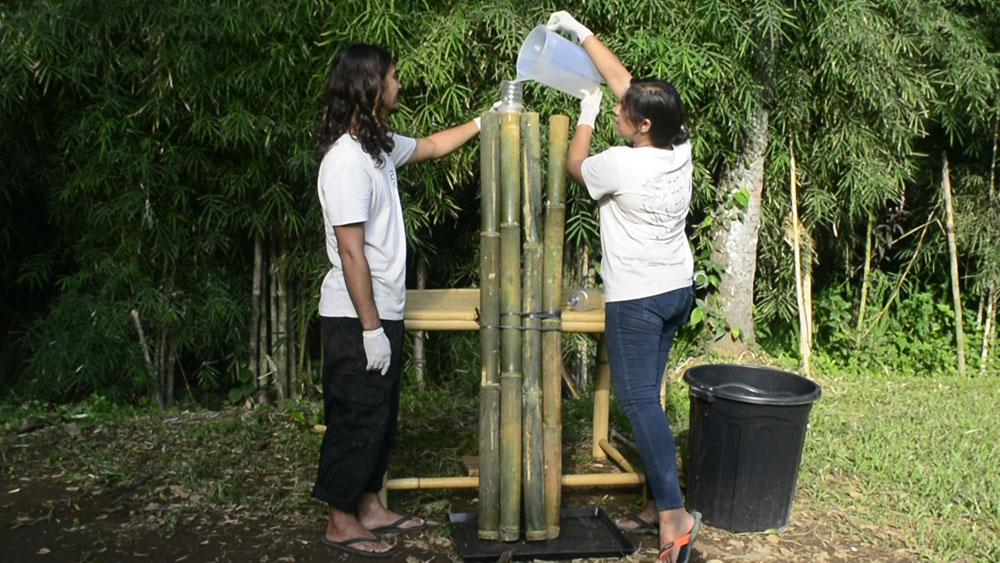
Bamboo is susceptible to insects like termites, borers, the powderpost beetle, and even fungi. If not treated properly, bamboo products and structures will only last a few years before they are eaten to dust. But don't get discouraged, there are many ways in which bamboo can be treated.
These methods include adding a borax based solution into the poles. You can do this through immersion, or pressure treatment using the Boucherie, or the modified Boucherie system. But in this article, we are going to talk about a special low-tech treatment option, the Vertical Soak Diffusion, or VSD.
VSD is an efficient treatment method for small projects or even large construction projects if you have a small budget. This is because it can be done with less equipment and very little investment.
In the VSD method, all the nodes of the bamboo pole except the last one are punctured with a long iron rod with a spearhead. Then, the bamboo poles are placed vertically, and the preservative is poured inside. Think about it like filling a long cup of bamboo with the preservative solution.
How do you make the Borax-boric acid solution?
To treat bamboo we use two types of borates: borax and boric acid because they are widely available, and minimally toxic (about 1.5x more toxic than regular table salt). Borax is a mineral also known
as sodium borate, sodium tetraborate, or disodium tetraborate. It is used as an ingredient in various cleaning products as an insect killer, fungicide, herbicide, and household cleaning agent [1]. Boric acid also is known as hydrogen borate, boracic acid, and orthoboric acid is a weakly acidic hydrate of boric oxide with mild antiseptic, antifungal, and antiviral properties. It is used in a widely at homes like a cleanser, stain-remover, disinfectant, deodorizer, and mold-killer. It also is used in cosmetic and pharmaceutical products [2].

Borax and boric acid are more environmentally friendly than other preservatives. Borax and boric acid are non-toxic to the environment but they are highly saline. If it is disposed of in smaller amounts, ground filters out the soil and does not pollute the groundwater. But in higher amounts, it is advisable to dilute it with water, and also some of the diluted solutions can be used as a herbicide. The VSD method was developed in Indonesia using three species of bamboo namely Dendrocalamus asper, Gigantochloa apus, Gigantochloa atter by the Environmental Bamboo Foundation
It is essential to treat only mature bamboo poles. Mature poles have reached their strength and completed the lignification process making it suitable for construction purposes. Young poles are not strong enough for construction and harvesting them can also negatively impact the health of the bamboo clump. Bamboo poles that are older than 5 years are harder and the inner wall becomes impermeable to the borax-boric acid solution [3]. So for treatment, use only mature poles that are 3-5 years old (depending on the species).
VSD Treatment Method
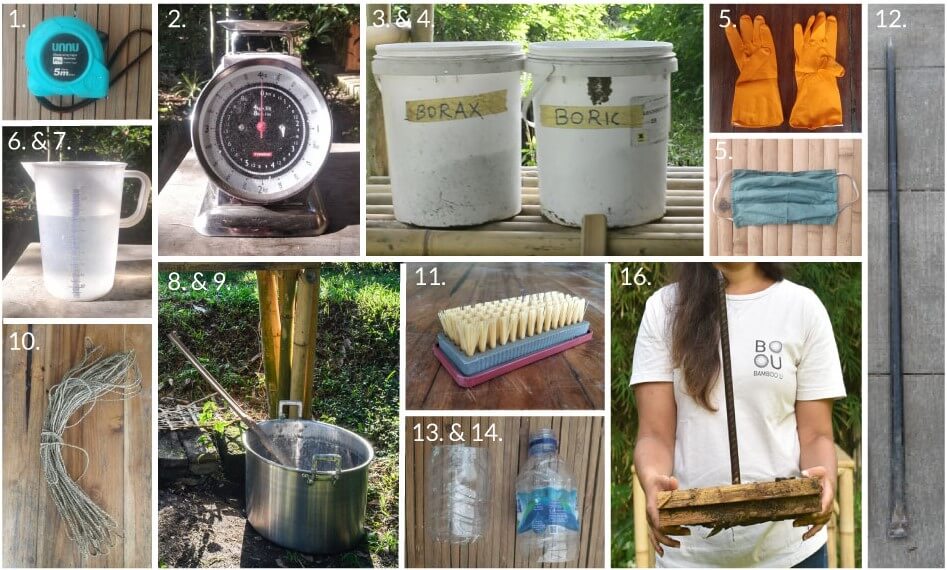
You will need the following tools and materials:
- Measuring tape
- Weigh scale
- Borax - 0.9 kg or 900 grams
- Boric acid - 0.6 kg or 600 grams
- Protective gear like gloves, rubber boots, and eye protection
- Warm water - 13.5 liters
- Jugs to pour the solution
- Containers to mix the solution
- Bamboo stick for stirring
- Rope to tie the bamboo
- Brush for cleaning
- Iron rod with a spearhead or something to puncture the bamboo
- Funnel to pour the solution in bamboo
- End caps to cover the bamboo poles
- A basin, tub, or tank to place the bamboo in.
- A small punching rod fixed vertically to a wooden base to punch the end node of bamboo.
- Red Textile dye as an indicator of complete absorption of the solution
Step 1: Prepare the bamboo poles
Bamboo poles should be treated soon after harvesting, but they can also be stand-cured for few days i.e. placing them on a stand in a shaded yet ventilated airy area, the stand should be lifted from the ground to avoid direct contact of bamboo with soil which is a route for bugs & a source of moisture retention. Stand-curing allows the transpiration process to go on which facilitates the drying process and also helps in the reduction of starch content in bamboo. For the diffusion process, you must use bamboo poles that are still moist and not dry, hence stand-cure should be done only for a few days and not too long for efficient treatment.

At this point, also check the bamboo poles for any cracks and use only the bamboo poles that have no cracks. Clean the harvested bamboo poles with a brush or coconut husk to remove any mold and dust. Tie the bamboo poles to a stand/table and puncture the bamboo nodes or diaphragms except for the last one with the iron rod. Make sure you don’t puncture the last node, you can make a mark on the iron rod at the length of the bamboo until the second to last node. Once the nodes have been punctured then place the bamboo poles vertically and tie them in place. These are ready for the borax-boric acid solution.
In case you have longer poles, you can use a scaffolding (a temporary structural framework used to support work crew during building construction) to reach to the top of the bamboo. Below is a picture showing the use of such scaffolding for longer bamboo poles.

Step 2: Prepare a 10% borax-boric acid solution

Now you need to know how much solution you need to prepare. To do this you have to know the volume of the solution that will fill the bamboo poles you have. To do this measure the length of the bamboo poles, and their internal diameter. We can consider the average for calculations unless there is a lot of variation in the dimensions. So pick a pole that is in between your largest and smallest pole. Below is an example of how to calculate the formula.
Let’s calculate for 4 bamboo poles of length 1500mm (1.5m or 4.9ft) with an average internal diameter of 50mm, thus a radius of 25mm.
For calculating the volume, we follow the volume of cylinder formula:
Volume of cylinder(V) : Pi x (r)2 x h where,
Pi = a constant value of 3.14
r = the radius of bamboo pole
h = the height or length of bamboo pole
Therefore, V = 3.14 x (25)2 x 1500
= 3.14 x 625 x 1500
= 2,943,750 mm3
As we have 4 bamboo poles, we multiply it by 4
= 2,943,750 x 4 = 11,775,000 mm3
Now we need to convert from cubic millimeter to liters,
1 litre = 1,000,000 mm3
V = 11,775,000/1,000,000 = 11.775 litres
Let’s prepare 15 liters of the solution considering an extra few liters to be on the safer side as the preservative may spill when you are pouring it. The poles are also tapering and irregular and we have to account for the refilling of bamboo poles every day as they will keep soaking the solution gradually. You’ll learn more about this later in this post.
Since we are preparing 15 liters of solution, out of which 90% need to be water and the remaining 10% is a mixture of borax and boric acid in a ratio of 6% borax and 4% boric acid.
90% Water = 13.5 litres
6% Borax = 0.9 litres/kg
4% Boric Acid = 0.6 litres/kg
-------------------------------------------
100% Solution = 15 litres.
Precaution: Wear all the protective gear as the borates can cause irritation to the skin and eyes. It is essential to keep it out of the reach of children.
We need to warm the water to help dissolve borax and boric acid easily so it is fully suspended in the water. Mix all the above amounts and keep stirring the solution with a bamboo stick until the borax-boric crystals completely dissolve in the mixture. You can add a red textile dye in the mixture as an indicator of the absorption of the solution by the bamboo if you want to be absolutely sure your borax is penetrating your bamboo.

Step 3: Pour the solution into the bamboo poles
The solution can then be poured into the bamboo poles using a funnel and a jug. For a larger scale, this can be done using pumps and a hose. If there is any leak in the bamboo pole due to a hole in bamboo, it can be repaired with bamboo pegs or wooden pegs. The solution will slowly get absorbed by the bamboo removing the starch out of the bamboo and the borax and boric solution will help to kill any insects that are present in the poles. This process may take 14- 18 days depending on the bamboo species. Each day the solution needs to be refilled until the red dye is visible on the entire wall thickness of the bamboo. If you don’t want to use red dye you will have to send some samples of your treated bamboo to a lab to test for borax content. Cover the poles with an end cap to not allow any evaporation. This entire setup is usually done under shade to avoid the impact of the sun on the poles. It also helps limit the evaporation of the solution.

After 14 days, puncture the last node by a small punching rod fixed vertically to a wooden base(refer the drawing below)to remove the leftover solution and dry the bamboo under shade.


The bamboo poles are ready to use for your Beautiful creations! Now, get ready to treat some bamboo. If you are interested in learning more about the right way to harvest bamboo poles and wish to get hands-on treating bamboo, join us at our next course at Bamboo U.
Sources:
This article is an adaptation of the book ‘Towards resilient bamboo forestry’ co-authored by Bamboo U facilitator Arief Rabik and Ben Brown
[1] Anne Marie Helmenstine, What Is Borax and How Is It Used?, Retrieved July 17, 2020, from https://www.thoughtco.com/what-is-borax-where-to-get-608509
[2] National Center for Biotechnology Information (2020). PubChem Compound Summary for CID 7628, Boric acid. Retrieved July 17, 2020, from https://pubchem.ncbi.nlm.nih.gov/compound/Boric-acid.https://pubchem.ncbi.nlm.nih.gov/compound/Boric-acid
[3] Rabik, A.,& Brown, B. (2003) p.295.Towards resilient bamboo forestry.Bali, Indonesia: Environmental Bamboo Foundation
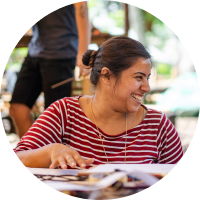
Architect and bamboo enthusiast from India. She came to Bali as a student visitor to research the potential of bamboo building and design.
June 7-18, 2024
The 11 Day Bamboo Build & Design Course in Bali
In 11 days, we'll show you how to build bamboo structures we’ll share all that it takes to build with nature.
April 26, 2024
The Fundamentals of Building with Bamboo Online Course
All the fundamentals you need to get you started working with bamboo. Deep dive into cinematic videos and step-by-step guides that will provide you with a strong understanding of bamboo as a design and building material.








